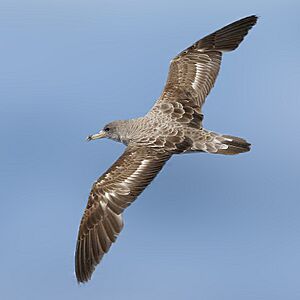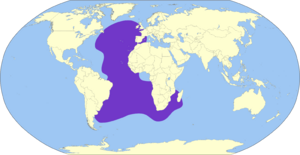Cory's shearwater facts for kids
Quick facts for kids Cory's shearwater |
|
|---|---|
 |
|
| Cory's shearwater in fight | |
| Conservation status | |
| Scientific classification | |
 |
Cory's shearwater (Calonectris borealis) is a large seabird that belongs to the shearwater family. These birds are known for gliding low over the ocean. They build their nests in large groups on rocky islands in the eastern Atlantic Ocean. When it's not breeding season, they travel far and wide across the Atlantic. This bird was once thought to be the same species as Scopoli's shearwater, but scientists now know they are different.
Contents
About the Name
Cory's shearwater was officially described in 1881 by an American bird expert named Charles B. Cory. He found a bird specimen near Chatham, Massachusetts. He gave it the scientific name Puffinus borealis at first.
Later, this bird was placed in the group (or genus) called Calonectris. This name combines ancient Greek words: kalos means "good" or "noble," and nectris means "swimmer." The second part of its scientific name, borealis, is a Latin word meaning "north." This refers to the northern areas where the bird lives.
Some other shearwaters look very similar. For example, the Cape Verde shearwater was once thought to be a type of Cory's shearwater. However, scientists now consider it a separate species. It lives only on the Cape Verde Islands.
Also, Scopoli's shearwater and Cory's shearwater used to be considered the same species. But after looking at their DNA, how they look, and their calls, experts decided they are two different species.
What They Look Like
This shearwater is quite large. It measures about 45 to 56 centimeters (18 to 22 inches) long. Its wings can spread out from 112 to 126 centimeters (44 to 50 inches) wide.
Cory's shearwater has brownish-grey feathers on its back and white feathers on its belly. It has a yellowish beak. You can tell it apart from other similar birds because it doesn't have a brown patch on its belly or dark marks on its shoulders.
Where They Live
These birds breed on islands in the Atlantic Ocean. You can find their breeding colonies on Madeira, the Azores, and the Berlengas Archipelago in Portugal. They also breed on the Canary Islands in Spain.
How They Behave
Cory's shearwaters fly with long, smooth glides. Their wings are usually bowed and angled slightly backward. This is different from the great shearwater, which flies with stiff, straight wings.
Nesting and Migration
Cory's shearwaters make their nests on open ground or among rocks. Sometimes, they dig a burrow to lay their single white egg. They visit their burrows mostly at night. This helps them avoid large gulls that might try to eat their eggs or chicks.
In late summer and autumn, most of these birds start to migrate. They fly north into the Atlantic Ocean. Some travel as far as the southwestern coasts of Great Britain and Ireland. They return to the Mediterranean Sea around February. The largest colony of Cory's shearwaters is found in the Savage Islands near Madeira.
What They Eat
Cory's shearwaters eat fish, molluscs (like squid), and scraps of food. They are good divers and can dive deep, sometimes 15 meters (50 feet) or more, to find their prey. They often follow fishing boats to find food. When they are around boats, they can get quite noisy, squabbling over food.
These birds are very social. You can often see them in large groups from ships or from certain headlands along the coast. The ferries crossing the Bay of Biscay are a great place to spot them. While they are silent at sea, their breeding colonies at night are full of loud, cackling calls.
Gallery








